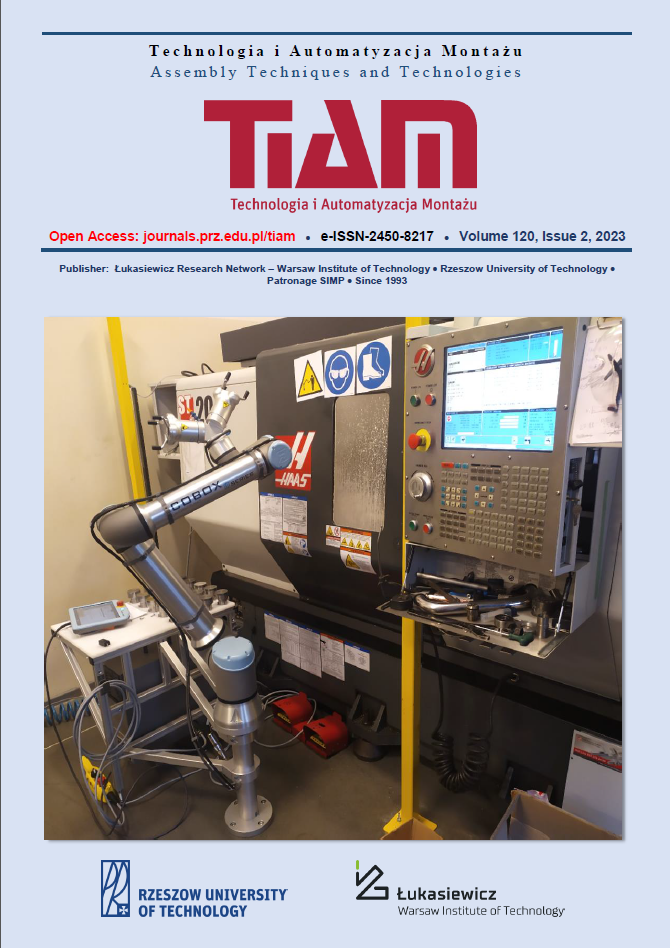Abstract
The aim of the article was to present issues related to the influence of the assembly joints technology (the type of adhesive material and the adhesive application) on the strength of the adhesive joints of poly(methyl methacrylate) (PMMA) used in the production of advertising elements. Angular adhesive joints, which are one of the types of joints made in the construction of advertising elements, were used in the study. The bonded material was poly(methyl methacrylate) (PMMA) of 8 mm thick. Two types of adhesives were used to make the adhesive joints: one-component solvent-based adhesives and methylene chloride as a solvent. Experimental tests determined the wettability of the surface of the adherends (with and without a protective coating) and the work of adhesion based on the measurement of the contact angle, as well as the strength of adhesive joints in accordance with the ISO 4578 standard. Based on the results of strength tests, it can be seen that the use of a solvent allows for obtaining equally strong joints as with the use of solvent. The purposefulness of using coatings protecting not only against dirt or mechanical damage in the form of scratches was also confirmed, but also the possibility of increasing (security) adhesive properties, defined in this case by wettability.
This is an Open Access article distributed under the terms of the Creative Commons Attribution License CC BY 4.0 (https://creativecommons.org/licenses/by/4.0/)
References
Żuchowska Danuta. 2000. Polimery konstrukcyjne: Wprowadzenie do technologii i stosowania. Warszawa: WNT.
Adams Robert D., Comyn John, Wake Wiliam Charles. 1997. Structural Adhesive Joints in Engineering Book. United Kingdom: Springer.
https://tuplex.pl, dostęp: 12.04.2023.
https://posshop.pl/materialy-pos, dostęp: 12.04.2023.
Rudawska Anna, Sztorc Piotr, Kujan Krzysztof. 2012. „Wpływ wybranych czynników konstrukcyjnych na wytrzymałość połączeń klejowych PVC oraz PMMA”. Przetwórstwo Tworzyw 5: 505–510.
Baldan Ahmet. 2012. „Adhesion phenomena in bonded joints”. International Journal of Adhesion and Adhesives 38: 95-116.
https://tuplex.rs/reklama/plyty-akrylowe-ekstrudowane/akcesoria/akcesoria-301, dostęp: 12.04.2023.
Zielecki Władysław, Pawlus Paweł, Perłowski Ryszard, Dzierwa Andrzej. 2013. ”Surface topography effect on strength of lap adhesive joints after mechanical pre-treatment”. Archives of Civil and Mechanical Engineering 13 (2): 175–185.
Rudawska Anna. 2010. „Wpływ sposobu przygotowania powierzchni na wytrzymałość połączeń klejowych blach ze stali odpornej na korozję”. Technologia i Automatyzacja Montażu 3: 36–39.
Chumble Rohan P., Darekar Deepak H. 2017. Influence of surface roughness of adherend on strength of adhesive joint”. International Journal of Engineering Development and Research 5 (4): 100–106.
Doluk Elżbieta, Rudawska Anna, Brunella Valentina. 2020. „The Influence of technological factors on the strength of adhesive joints of steel sheets”. Advances in Science and Technology Research Journal 14(1): 107-15.
Rudawska Anna, Izabela Miturska, Dana Stančeková,. 2020. The effect of the surface preparation method on the ultimate strength of single lap adhesive joints of selected construction materials. Technologia i Automatyzacja Montażu 4: 14–20.
Boutar Yasmina, Naïmi Sami, Mezlini Salah, Ali Moez B.S. 2016. „Effect of surface treatment on the shear strength of aluminium adhesive single-lap joints for automotive applications”. International Journal of Adhesion and Adhesives 67: 38–43.
https://sklep.biomus.eu/pl/108-methylene-chlorek, dostęp: 12.04.2023.
https://www.technicoll.eu/adhesive/technicoll-108.html, dostęp: 12.04.2023.


